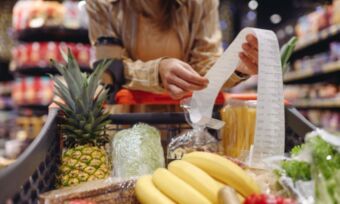8 grocery swaps that can save you money
A trip to the supermarket can be expensive. Here are eight swaps you can make to reduce your grocery bill.

A trip to the supermarket can be expensive. Here are eight swaps you can make to reduce your grocery bill.
The cost-of-living crunch continues to bite and one of the places Aussies are feeling the pain most is at the supermarket checkout. Groceries are a necessity, so you can’t simply stop shopping to cut costs but there are a few easy swaps you can make to help you save money. Here are eight to consider next time you’re doing your weekly shop.
Canstar Blue also compares supermarkets so you can find out what other Aussies think about the compared brands before you go ahead with a purchase.
Swap 1: Packaged for loose
There’s no denying that buying a bag of pre-cut lettuce or sliced mushrooms can be a convenient option but that convenience comes at a cost. More often than not you’ll find that buying loose items will be cheaper than buying them packaged. Sometimes that might be the case even if the produce hasn’t been cut.
Here are a few examples:
- Shredded iceberg lettuce costs $10 per kilo but you can buy iceberg lettuce for $2.50 each (about $4.50 per kilo for a medium-sized one).
- A 200-gram punnet of sliced mushrooms will set you back $4 ($20 per kilo) but buy them loose and cut them yourself and you’ll only pay $12.50 per kilo.
- Green cayenne chillies cost $76 per kilo when they are packaged but are just $30.01 per kilo when you buy them loose.
Swap 2: Slices of cheese for blocks
Cheese is another grocery product where convenience can come at a cost. Buying your cheese sliced or shredded will generally cost you more than buying a block so it’s worth taking a closer look at the price.
One example is Cheer Tasty Cheese. A 48-pack of sliced cheese will cost you $14 ($18.67 per kilo) but you can buy a 1kg block for $14.95 – almost $4 a kilo less.
Swap 3: Perfect for imperfect
Just because something doesn’t look perfect doesn’t mean it isn’t any good. While in the past fruit and vegetables that had an unusual shape or had a few marks didn’t make it off the farm, it’s now possible to buy ‘ugly’ or ‘imperfect’ fruit and veg for a discounted price.
At Coles they’re branded ‘I’m Perfect’ and Woolworths uses the label ‘Odd Bunch’. You can also buy imperfect produce from specialty providers such as Good & Fugly and Farmers Pick. Farmers Pick estimates its customers save up to 30% every week on their fresh produce shop.
Swap 4: Fresh for frozen
Making the switch from fresh fruit and veg to frozen can be a great way to get more bang for your buck. And the good news is you don’t miss out on any of the health benefits by opting for frozen. Research shows that frozen fruit and veg are just as good as fresh.
So how much can you save? Let’s have a look at a few examples:
- You can buy a 125-gram punnet of fresh raspberries for $5 ($40 per kilo) but if you opt for the frozen version you can get 500 grams for $7 ($14 per kilo).
- A 280-gram bag of spinach costs $5 ($17.86 per kilo) but you can get 250 grams of frozen chopped spinach for almost half the price – $2.80 ($11.20 per kilo).
Swap 5: Brand name for generic
When you’re shopping for groceries it’s easy to buy the brands you’re used to but it can pay to move out of your comfort zone and give generic brands a try. You might be surprised at the result – and your wallet may thank you for it.
Canstar has crunched the numbers that a family of four who switches 50% of their groceries to supermarket-owned brands could potentially cut their annual grocery bill by a whopping $2,088!
You can start with staples such as flour and rice before you move on to treats like biscuits and chips.
Aldi is also worth a look as it offers brand imitation products that are often as good – if not better – than the real thing. Apparently, Aldi’s version of Wagon Wheels – Cart Wheels – are a winner and are $2 cheaper.
Swap 6: Individual portions for bigger packets
Buying snacks in individual portions can make packing lunch boxes easier and can also help with portion control but this is another convenience that may cost you. Consider buying bigger packets and then portioning them yourself into smaller containers.
Let’s look at Smith’s Cheese Twisties, for example. Six single-serve packs cost $4.50 ($3.95 per 100g) but you can buy a 270g party bag for $4 ($1.48 per 100g). That’s not a bad saving…
Swap 7: New for refills
From hand wash and shampoo to fabric softener and cleaning products buying refills can be a great way to save money and can also help reduce plastic waste.
To give you an idea of the potential savings a 250ml bottle of Palmolive foaming lime & mint hand wash costs $4 ($1.60 per 100ml). The 1-litre refill bottle is $9.00 ($0.90 per 100ml). So instead of buying a brand new bottle of hand wash when yours runs out, you can buy the refill version and top the original container up.
Swap 8: Shopping by price for unit price
One of the best swaps you can make at the supermarket is to look at the unit price instead of just the ticket price. When products come in different shapes, sizes and brands it’s not always obvious which one will give you the best value. Unit pricing makes it easier to compare prices because it uses a standard unit of measurement. You can usually find the unit price on the shelf label in stores or close to the product image if you’re shopping online.
Note: All prices in the examples were correct at the time of writing.
Cover image source: SewCreamStudio/Shutterstock.com






